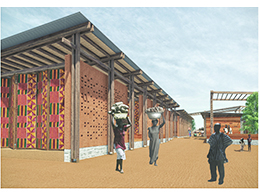STUDENTS PROJECTS
PROJECTS2013

27 February, 2015
Orphan Children Shelter. Public space of social uses in Ghana
Analysis of the culture using the traditional materials.
Student : Aleksaki Olga - Natassa, Gouvali Olga
Supervisor : Stavridis Stavros
Consultants : Vasilatos Panagiotis, Klampatsea Irene
National Technical University of Athens, school of Architecture Engineering
Presentation date : 10/4/2014
The diploma project is situated in Ghana's capital city Accra, specifically in the area of Alajo. The designing procedure was based on the analysis of the traditional Ghanaian method of weaving, Kente. Refuge for the orphans, social and psychological support and public markets are situated on the site. Rammed earth and earthblocks consist the energy - aesthetic - traditional methods of building.

After our trip to Ghana and the experience of Ghanaians' civilization, tradition and everyday life, we considered the ways that people could be relieved in many aspects of their lives. Given that the number of orphans in Ghana is huge and the attention given scarce, we decided to proceed in relevant design. Other factors that lead us to the choice of Ghana are the challenge of facing different weather conditions than those of Greece and the use of traditional building materials (raw earth etc.), for a minus building cost and a handmade sustainable architecture.
Ghana: tropic climate, absent wind
- 71% of people have no access to drinkable water
- Maternal deaths reach 4% and the orphans add up to 1.100.000
Accra has up to 3 million citizens. It's the biggest city and economic centre of the country. The Britain colonists sort of divided the city in indigenous regions and colonies. Accra has today three types of regions, the rich ones (former colonial), the slums which contain most crime activity and diseases and the medium ones with shortage of infrastructures such as Alajo.)

- lack of urban design
- lack of drainage system
- insufficient water supply, often floods during the rain periods - seasons
- lack of public places and parks
- one - store buildings, poor prefabricated metal or wooden constructions
- weavers, wandering dealers, merchants, farmers, women carry on head others' products for a small payment or sell their food out of their houses
Next to the chosen site there is a tro - tro station (local bus station), in which orphans and homeless people find shelter during the night. So, this phenomenon could be relieved by the construction of the orphanage next to this area.)

Our target was the creation of an environment familiar to its users, based on their strong traditions and combined with their traditional construction methods too. The most ancient traditional art of Ghanaians is the weaving method of Kente.
- It is worn especially in ceremonies, festivals and other important gatherings.
- The patterns of the cloths seem to evolve along with the social evolution.
- There are over 300 patterns, each one with its own name and meaning.
- The threads stretch from the weaving machine and get bind on a heavy rock 5 to 6 meters far. And the weaving begins. The final product has only 10cm length. The produced cloth consists of many pieces sewn together.
The specific rhythm and repetition of the patterns of a Kente cloth have been architecturally translated into grid and equal and repetitive proportions of the building compartments. The different uses have been organized into strips like those of the kente cloth. As the threads stretch away from the weaving machines, so we created "engravings" on the plan of the site that begin from the neighboring buildings' edges. The weaving procedure begins with the stretching of the threads on the weaving site, ending up to a strict geometrically cloth. In our case, wooden canopies were created, based on the weaving threads, under which building compartments are strictly organized. Beginning from the East, there is the social workers' centre (Accra lacks in social workers) so that children have always the needed support. After that the social kitchen is situated. Women of Alajo can sell their food in there (instead of on the road) either to the children of the orphanage or the people of Alajo. Furthermore, there is the orphanage's reception centre and next to it the 6 sleeping chambers in which children are assigned based on their age. The building compartments have inclined metal roofings that protect from the heavy rainfall and at the same time gather the water into water tanks in the ground. Because of the floods, the structure is about a meter higher from the ground and the earth blocks and rammed earth have a base of rocks for sustaining reasons and protection. Instead of ordinary doors wooden panels filled with the kente cloth are used in every opening. The organization of the uses is studied so that urban sites for playing, gathering and everyday activities are done according to the Ghanaian way of life (space among the buildings). The orphanage is quite extroverted but at the same time provides protection to the children. In the public space, linear markets have been designed under the wooden canopies (threads) destined for the dealers and the merchants of the area, combined with the open spaces. The dense urban fabric will now have a way of relief and the site will have the same vivid character as the rest of Alajo. In the public space are also situated three buildings where the weavers will work on their cloths, while they will be able to exhibit them on the linear markets. The kente weaving centre will be open to everyone who wants to practice the traditional art. On the following images the design principles, the design elements and the construction methods will be analysed.)














